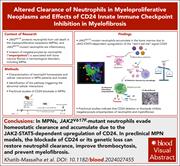Issue Archive
Table of Contents
BLOOD COMMENTARIES
PERSPECTIVE
Counterpoint: the design and interpretation of blood transfusion randomized clinical trials
Clinical Trials & Observations
Designing randomized clinical trials (RCTs) that are fit for purpose to answer burning questions in routine practice is difficult, and the interpretation of their results, particularly beyond the primary end point, can be controversial. This is no more so than in transfusion medicine, where debate rages between restricted and liberal transfusion strategies for patients with acute and chronic cardiovascular disease. Carson et al discuss 4 published RCTs, provide their perspective on why the trial designs remain valid, and conclude that more evidence is required before consensus can be reached on transfusion thresholds for anemic patients with atherosclerotic cardiovascular disease.
HOW I TREAT
How I treat acute lymphoblastic leukemia in the era of immunotherapy while revisiting the myth of second remission
Great strides forward have been taken in the last decade in the management of acute lymphoblastic leukemia in adults via the application of genomics, monitoring of measurable residual disease, and introduction of immunotherapy. It is timely that Aldoss et al outline how they use these advances as they address the challenges provided in 4 real-world cases. They highlight that allogeneic stem cell transplantation in first remission can now be avoided or deferred to second remission for many patients.
CLINICAL TRIALS AND OBSERVATIONS
Daratumumab-bortezomib-thalidomide-dexamethasone for newly diagnosed myeloma: CASSIOPEIA minimal residual disease results
Clinical Trials & Observations
Multiple meta-analyses indicate that achieving minimal residual disease (MRD) negativity is a valid surrogate for long-term benefit in newly diagnosed multiple myeloma (NDMM), but the story continues to evolve as we learn how best and when to measure it and what level of negativity is most informative. Corre and colleagues report the long-term results of the 2-part randomized trial of adding daratumumab to initial therapy and/or as maintenance for transplant-eligible patients with NDMM. Daratumumab increases MRD clearance below the 10−6 threshold and improves progression-free survival (PFS). Strong concordance between multiparameter flow cytometry and molecular methods of MRD detection is present, and the use of daratumumab appears to reduce the negative prognostic impact of selected cytogenetic abnormalities. In a combined analysis across 2 data sets, Giri et al report that sustained MRD negativity at the 10−5 threshold is the most effective predictor of PFS after daratumumab-containing quadruplet therapy for patients with NDMM, outperforming single-point MRD negativity, including using the 10−6 threshold. However, among patients achieving sustained MRD negativity, high-risk genetic features remain prognostic. Consequently, how we best utilize MRD data to guide care outside trials requires ongoing refinement.
HEMATOPOIESIS AND STEM CELLS
Coordinated regulation of self-renewal and cell cycle during human lympho-myeloid lineage restriction
Lack of adequate culture systems for long-term in vitro study of human stem cell populations has limited our understanding of drivers of differentiation. Wang et al utilized a permissive defined system and bulk and single-cell analyses to identify novel molecular and biological changes in CD34+ cells as they lose self-renewal potential and acquire lineage-restricted properties. Their work highlights a shared mechanism of proliferation control during monocyte/neutrophil and B-cell lineage commitment.
LYMPHOID NEOPLASIA
Optimal MRD-based end point to support response-adapted treatment cessation in newly diagnosed multiple myeloma
Clinical Trials & Observations
Multiple meta-analyses indicate that achieving minimal residual disease (MRD) negativity is a valid surrogate for long-term benefit in newly diagnosed multiple myeloma (NDMM), but the story continues to evolve as we learn how best and when to measure it and what level of negativity is most informative. Corre and colleagues report the long-term results of the 2-part randomized trial of adding daratumumab to initial therapy and/or as maintenance for transplant-eligible patients with NDMM. Daratumumab increases MRD clearance below the 10−6 threshold and improves progression-free survival (PFS). Strong concordance between multiparameter flow cytometry and molecular methods of MRD detection is present, and the use of daratumumab appears to reduce the negative prognostic impact of selected cytogenetic abnormalities. In a combined analysis across 2 data sets, Giri et al report that sustained MRD negativity at the 10−5 threshold is the most effective predictor of PFS after daratumumab-containing quadruplet therapy for patients with NDMM, outperforming single-point MRD negativity, including using the 10−6 threshold. However, among patients achieving sustained MRD negativity, high-risk genetic features remain prognostic. Consequently, how we best utilize MRD data to guide care outside trials requires ongoing refinement.
MYELOID NEOPLASIA
Defective neutrophil clearance in JAK2V617F myeloproliferative neoplasms drives myelofibrosis via immune checkpoint CD24
While it is clear that increased thrombopoietin receptor signaling plays a central role in the development of bone marrow (BM) fibrosis in myeloproliferative neoplasms (MPNs), the exact mechanism of BM fibrosis in MPNs is unknown. Khatib-Massalha et al used human samples and murine models to show that upregulation of CD24 by JAK2V617F in neutrophils inhibits their clearance, leading to an accumulation of senescent neutrophils that interact with megakaryocytes to induce the release of active transforming growth factor β (TGF-β) and the development of myelofibrosis. Blocking CD24 in vivo restores neutrophil clearance and prevents the development of BM fibrosis in murine MPN models.
RED CELLS, IRON, AND ERYTHROPOIESIS
Reactivation of developmentally silenced globin genes through forced linear recruitment of remote enhancers
THROMBOSIS AND HEMOSTASIS
Genome-wide meta-analysis of heavy menstrual bleeding reveals 36 risk loci
Genome-wide association studies identify associations between genetic loci and clinical phenotypes of interest and often help explain common phenotypes underpinned by interactions between multiple loci. Thibord and colleagues present results from the largest genome-wide meta-analysis of heavy menstrual bleeding, identifying more than 30 common genetic loci associated with risk for this common condition. Their findings shed light on links to genetic risk for uterine fibroids and altered hormone regulation, among others, and pinpoint the F5-Leiden variant as having a strong protective effect. These clues will require more focused investigations to piece together a full understanding of this complex clinical condition.
TRANSFUSION MEDICINE
Inhibition of terminal complement complex formation alleviates murine antibody-mediated TRALI
Brief Report
BLOOD WORK
ERRATUM
-
Cover Image
Cover Image
![issue cover]()
Immunofluorescence showing bone marrow megakaryocytes (green), neutrophils (red), and cell nuclei (blue) in a mouse model of polycythemia vera. Note the presence of emperipolesis with neutrophils inside megakaryocytes. Both emperipolesis and associated marrow fibrosis were corrected by CD24 blockade. See the article by Khatib-Massalha et al on page 717.
- PDF Icon Front MatterFront Matter
- PDF Icon Table of ContentsTable of Contents
- PDF Icon Editorial BoardEditorial Board
Advertisement intended for health care professionals
Email alerts
Advertisement intended for health care professionals











Myeloma: a sky full of MRD stars
Clinical Trials & Observations